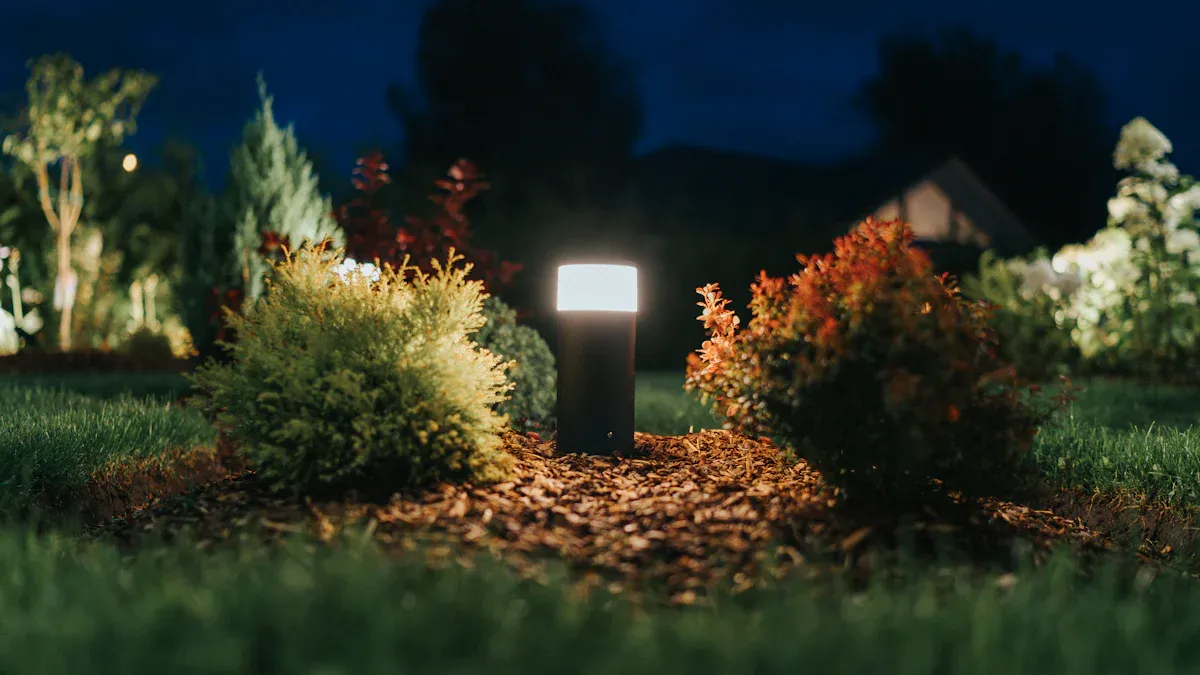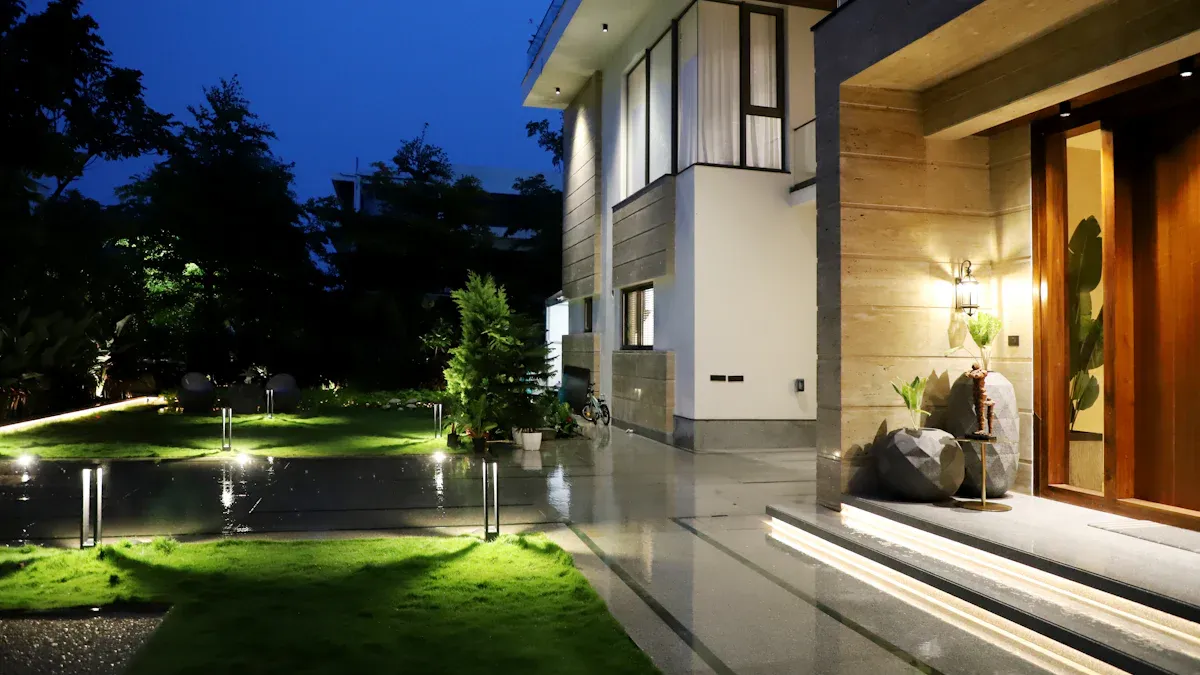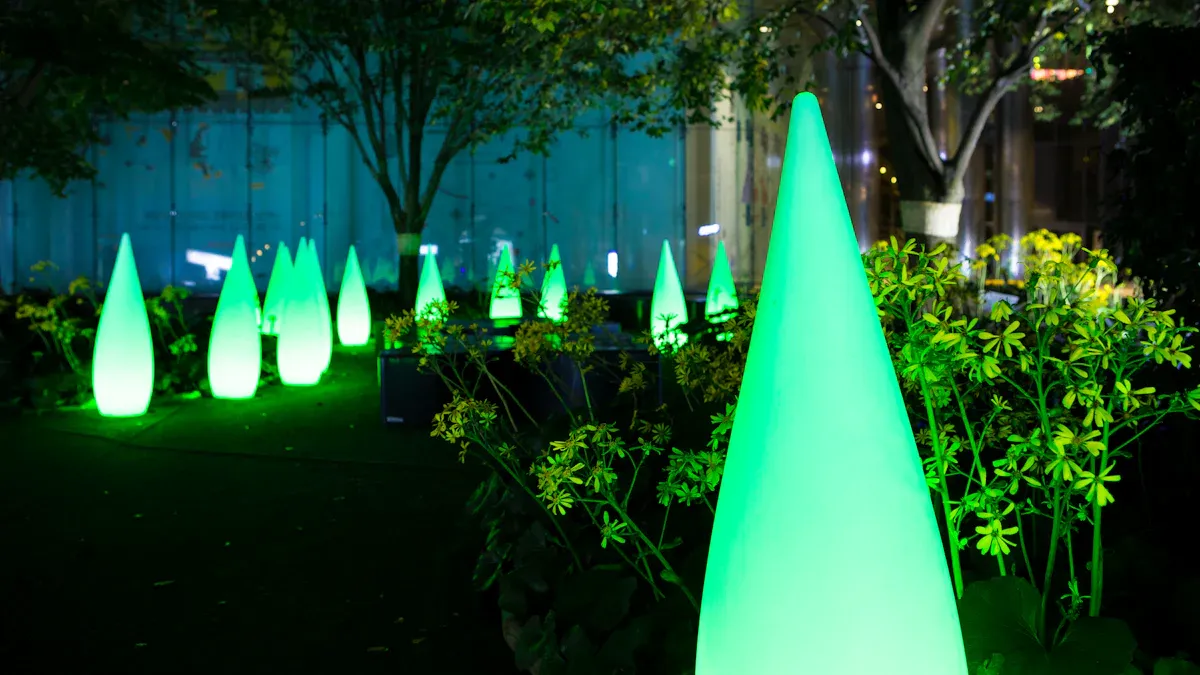
The rapid evolution of technology and sustainability demands has transformed the commercial landscape lighting industry. Businesses that embrace innovative solutions in 2025 can create safer, more visually appealing outdoor spaces while achieving strategic goals. The outdoor lighting market, valued at USD 14,499 Million in 2025, is projected to grow at a CAGR of 7.2% through 2035. This growth highlights the increasing need for advanced systems like smart LED lighting and solar-powered designs. By partnering with a reliable landscape lighting company and utilizing professional landscape lighting installation services, businesses can enhance energy efficiency, reduce costs, and align with environmental objectives. Additionally, comprehensive landscape lighting services can further optimize outdoor aesthetics and functionality, ensuring that every space is beautifully illuminated.
Key Takeaways
- Use smart lighting systems to control outdoor lights from afar. This saves energy and lets you adjust lights as needed.
- Switch to LED lights to cut electricity costs. LEDs use much less energy than old bulbs and last longer, saving money over time.
- Try solar-powered lights to help the environment. New solar lights work well even with little sunlight, needing less regular electricity.
- Set up programmable lights to make outdoor spaces exciting. Change brightness and colors for events or seasons to impress customers and show off your brand.
- Add motion-sensor lights to keep areas safe and secure. These lights turn on only when needed, saving energy and keeping spaces bright.
Smart Landscape Lighting Systems

IoT Integration for Smarter Control
The integration of IoT (Internet of Things) technology has revolutionized landscape lighting systems. Businesses can now control outdoor lighting remotely through mobile apps or centralized dashboards. This capability allows for real-time adjustments, ensuring optimal illumination based on weather, time of day, or specific events. IoT-enabled systems also provide valuable data insights, such as energy consumption patterns, helping businesses make informed decisions.
The growing adoption of IoT in lighting is evident in market trends.
| Evidence Type | Details |
|---|---|
| Market Growth | The smart lighting market is expected to grow to approx. USD 25 Billion by 2023. |
| CAGR | The market is projected to grow at a CAGR of 27% between 2016 and 2023. |
| Regional Insights | Europe is expected to hold the highest market share, with Asia-Pacific growing the fastest. |
| Application Growth | Smart street lighting systems are projected to exhibit the fastest growth with a CAGR over 25%. |
These advancements highlight the potential of IoT to transform commercial landscape lighting into a more efficient and responsive system.
Automated Lighting for Efficiency
Automated lighting systems enhance energy efficiency and reduce operational costs. These systems use sensors and timers to adjust lighting based on occupancy or natural light levels. For example, motion sensors can activate lights in parking lots or pathways only when needed, minimizing energy waste.
Case studies demonstrate the effectiveness of automation in commercial settings:
| Case Study Description | Key Outcomes |
|---|---|
| Retail Locations Optimization | $6.2M annual energy savings, $2.05M operational savings, $2.7M in utility rebates. |
| University Lighting System | Nearly $600,000 in energy cost savings. |
| Automation Solutions | Real-time energy consumption adjustments leading to operational efficiency and reduced greenhouse gases. |
These examples underscore how automated lighting systems not only save costs but also contribute to sustainability goals.
Practical Applications in Commercial Spaces
Smart lighting solutions have been successfully implemented in various commercial spaces, showcasing their versatility and impact. For instance, the Empire State Building underwent an LED retrofit that reduced energy consumption and maintenance costs while improving light quality. Similarly, Boston University integrated smart controls into its extensive LED upgrade, achieving significant energy savings.
Other notable projects include:
| Location/Project | Description |
|---|---|
| Philadelphia Navy Yard | Advanced smart lighting system with sensors for energy efficiency and safety. |
| Chicago O’Hare Airport | LED conversion improved visibility and reduced energy use. |
| Miami Tower | Dynamic LED system enhanced aesthetic appeal and reduced energy consumption. |
These practical applications demonstrate how businesses can leverage smart landscape lighting to enhance functionality, aesthetics, and sustainability. Ninghai County Yufei Plastic Electric Appliance Factory offers innovative solutions that align with these trends, helping businesses stay ahead in 2025.
Energy-Efficient LED Landscape Lighting
Cutting-Edge LED Advancements
Recent advancements in LED technology have revolutionized commercial landscape lighting. Modern LEDs now offer unparalleled energy efficiency, durability, and design flexibility. Their compact size allows seamless integration into architectural designs, enhancing both aesthetics and functionality. Additionally, LEDs provide consistent, flicker-free illumination with excellent color rendering, improving visibility and safety in outdoor spaces.
Key innovations include adaptive lighting systems that adjust brightness and color temperature based on occupancy or ambient light. This feature not only optimizes energy use but also creates a more comfortable environment for users. Furthermore, the integration of LEDs with IoT platforms enables remote control and diagnostics, streamlining maintenance and reducing operational costs.
- Additional advancements include:
- Human-centric lighting that mimics natural light cycles to support well-being.
- Enhanced optics for precise light distribution in commercial settings.
- LiFi technology, which allows data transmission through light modulation, offering dual functionality.
These innovations demonstrate how LEDs continue to set new standards in energy-efficient landscape lighting.
Cost and Environmental Benefits
LEDs provide significant cost savings and environmental advantages compared to traditional lighting technologies. Their energy efficiency reduces electricity consumption, leading to lower utility bills. According to the U.S. Energy Information Administration:
LED lighting uses at least 75% less energy than incandescent bulbs, with some firms reporting savings in lighting energy consumption as high as 80%.
Additionally, LEDs last up to 25 times longer than incandescent bulbs, minimizing replacement costs and waste. This durability makes them a sustainable choice for businesses aiming to reduce their carbon footprint.
Modern LEDs operate at higher efficiencies, converting more electricity into light rather than heat, resulting in significant reductions in power consumption and costs. Although the initial investment may be higher, the long-term savings provide an excellent return on investment.
By adopting LED solutions, businesses can align their operations with environmental goals while achieving substantial financial benefits.
Real-World Examples of LED Adoption
The widespread adoption of LED technology highlights its transformative impact on commercial landscape lighting. In 2018 alone, the U.S. achieved annual energy savings of 1.3 quadrillion Btu, translating to $14.7 billion in cost savings for consumers. Outdoor LED penetration reached 51.4%, contributing to 40% of total energy savings in the outdoor sector.
| Statistic | Value |
|---|---|
| Annual U.S. energy savings (2018) | 1.3 quadrillion Btu |
| Cost savings for consumers (2018) | $14.7 billion |
| Outdoor LED penetration | 51.4% |
| Contribution of outdoor sector to total energy savings (2018) | 40% |
Programs like UJALA have further demonstrated the potential of LEDs. By distributing 360 million LED bulbs, the initiative saved over 47 billion kWh annually and reduced CO2 emissions by 37 million tons. These examples underscore the role of LEDs in driving energy efficiency and sustainability in commercial spaces.
Ninghai County Yufei Plastic Electric Appliance Factory offers cutting-edge LED solutions that align with these advancements, helping businesses achieve their energy and environmental goals.
Sustainable Landscape Lighting Solutions
Solar-Powered Lighting Innovations
Solar-powered lighting continues to gain traction as a sustainable solution for commercial outdoor spaces. Recent advancements have made these systems more efficient and versatile. Innovations like bifacial solar panels now capture sunlight from both sides, increasing energy generation even in low-light conditions. Wireless integration has also simplified installation, allowing businesses to place fixtures in optimal locations without extensive wiring.
Incorporating solar-powered lighting into renewable microgrids has further enhanced its appeal. These systems not only reduce reliance on traditional energy sources but also promote sustainable urban development. For example:
- Solar panels now charge faster, enabling shorter downtime for lighting systems.
- Smart integration allows remote control and energy monitoring, ideal for large-scale commercial projects.
- IoT-enabled automation enhances flexibility, enabling businesses to adjust lighting based on real-time needs.
These innovations demonstrate how solar-powered lighting can transform outdoor spaces into energy-efficient and eco-friendly environments.
Eco-Friendly Materials and Designs
The shift toward eco-friendly materials and designs is reshaping the landscape lighting industry. Manufacturers are prioritizing recyclable materials like glass, wood, and bioplastics to minimize environmental impact. LED solutions, recognized as the gold standard, consume up to 80% less energy than traditional bulbs, according to the U.S. Department of Energy.
LED underground lights have become a popular choice for architects and designers. These fixtures provide reliable, long-lasting illumination while reducing waste and replacement needs. Sustainable materials combined with energy-efficient technologies are expected to dominate outdoor lighting trends in 2025. This approach not only enhances the aesthetic value of outdoor spaces but also aligns with global sustainability goals.
Aligning Lighting with Corporate Sustainability Goals
Businesses are increasingly aligning their lighting strategies with corporate sustainability objectives. Smart lighting technology plays a pivotal role in this effort. Systems equipped with occupancy and daylight sensors can reduce energy consumption by 35% to 45%. These solutions also enable precise energy reporting, helping organizations meet their sustainability targets.
Integrating smart lighting with other building systems optimizes energy savings and improves overall efficiency. For instance, automated controls can adjust lighting levels based on usage patterns, reducing waste and enhancing operational performance. By adopting sustainable lighting practices, businesses can demonstrate their commitment to environmental stewardship while achieving cost savings.
Ninghai County Yufei Plastic Electric Appliance Factory offers innovative solutions that align with these trends, empowering businesses to create sustainable and visually appealing outdoor spaces.
Dynamic and Customizable Landscape Lighting

Programmable Lighting for Versatility
Programmable lighting systems have redefined the possibilities for outdoor spaces, offering unmatched versatility. These systems allow businesses to adjust brightness, color, and patterns to suit specific events or seasons. For example, a restaurant can create a warm ambiance for evening diners or switch to vibrant hues for festive celebrations.
The growing demand for programmable lighting is evident in its widespread adoption across industries:
- The programmable stage lighting market reached a valuation of $4.94 billion in 2023, reflecting its popularity.
- Concerts alone accounted for $1.4 billion, showcasing the role of advanced lighting in creating immersive experiences.
- Theater productions contributed $1.1 billion, highlighting the importance of programmable lighting in engaging audiences.
These statistics underscore the potential of programmable lighting to transform commercial outdoor spaces into dynamic environments that captivate visitors.
Branding Through Tailored Lighting Designs
Customizable lighting solutions offer businesses a unique opportunity to reinforce their brand identity. By tailoring lighting designs to reflect brand colors, logos, or themes, companies can create a memorable impression on customers. For instance, a hotel chain can use lighting to project its logo onto building facades, enhancing visibility and brand recall.
The rising consumer demand for aesthetically pleasing outdoor lighting solutions has fueled this trend. The landscape lighting power supply market is projected to grow from $500 million in 2025 to $900 million by 2033, driven by the adoption of energy-efficient LED lighting and increased investments in outdoor infrastructure. This growth highlights the importance of lighting as a branding tool in commercial spaces.
Creative Applications in Commercial Outdoor Spaces
Innovative lighting applications have transformed commercial outdoor spaces into visually stunning environments. Businesses are leveraging creative solutions to enhance functionality and aesthetics:
- Digital Signage with Integrated Lighting: LED backlighting and RGB LEDs improve the visibility and impact of signage.
- Seasonal and Festive Lighting: String lights and themed installations create a celebratory atmosphere, boosting brand visibility.
- Dynamic Facade Lighting: Programmable LED fixtures change building appearances, synchronizing with events or promotions.
These applications demonstrate how businesses can use lighting to elevate customer experiences while achieving strategic goals. Ninghai County Yufei Plastic Electric Appliance Factory provides innovative solutions that align with these trends, empowering businesses to stay ahead in 2025.
Landscape Lighting for Safety and Security
Motion-Sensor Lighting for Protection
Motion-sensor lighting has become a vital component in enhancing security across commercial properties. These systems activate lights only when movement is detected, ensuring that critical areas remain illuminated when needed. This feature not only conserves energy but also deters potential intruders by drawing attention to their presence.
- Motion-sensor lighting improves safety in entryways and common areas, reducing the risk of accidents and criminal activity.
- In hospitality environments, these lights create a secure and welcoming atmosphere for guests.
- Office buildings benefit from enhanced visibility in parking lots and pathways, ensuring employee safety during late hours.
By integrating motion-sensor lighting, businesses can achieve a balance between security, energy efficiency, and user comfort.
Effective Pathway and Parking Area Illumination
Proper illumination of pathways and parking areas is essential for reducing accident risks and ensuring smooth navigation. Well-lit parking lots allow drivers to see obstacles, other vehicles, and pedestrians clearly, minimizing the likelihood of collisions. Similarly, illuminated pathways guide pedestrians safely, especially in low-light conditions.
- Adequate lighting in parking lots significantly reduces accident risks.
- Enhanced visibility helps both pedestrians and drivers navigate safely.
- Proper lighting ensures that obstacles and hazards are easily identifiable.
These measures not only improve safety but also enhance the overall user experience in commercial spaces.
Creating Safe and Inviting Environments
Enhanced lighting strategies play a crucial role in creating safe and inviting commercial environments. Businesses that prioritize outdoor lighting can improve user experiences while ensuring safety after dark. For example, advanced lighting controls in office buildings adjust brightness automatically, allowing for safe navigation during evening hours. Hospitals often use basic outdoor lighting systems that activate at dusk, creating a welcoming atmosphere for visitors and staff.
“Well-designed landscape lighting transforms outdoor spaces into secure and comfortable environments, fostering a sense of safety and trust among users.”
By adopting advanced lighting solutions, businesses can elevate their outdoor spaces, ensuring they are both functional and aesthetically pleasing.
The top five trends in commercial landscape lighting for 2025—smart systems, energy-efficient LEDs, sustainable solutions, dynamic designs, and safety-focused lighting—are reshaping outdoor spaces. These innovations enhance functionality, reduce energy consumption, and elevate aesthetics. Businesses adopting these trends can achieve strategic goals while aligning with sustainability objectives.
Market analysis reports emphasize the importance of consulting professionals or exploring innovative products to remain competitive.
| Report Title | Key Insights |
|---|---|
| Lighting Market By Lighting Type & Application | Highlights market trends, growth projections, and the importance of consulting professionals for competitiveness. |
| LED Lighting Market SIZE & SHARE ANALYSIS | Emphasizes the U.S. market’s focus on energy efficiency and smart lighting innovations. |
| US LED Lighting Market SIZE & SHARE ANALYSIS | Discusses opportunities for new entrants and the importance of strong relationships with contractors. |
Ninghai County Yufei Plastic Electric Appliance Factory offers cutting-edge solutions that align with these trends, empowering businesses to stay ahead in the evolving landscape lighting industry.
FAQ
What are the key benefits of smart landscape lighting systems?
Smart lighting systems offer remote control, energy efficiency, and automation. Businesses can adjust lighting based on real-time needs, reducing energy waste. These systems also enhance safety and aesthetics, making them ideal for commercial spaces.
How do LEDs contribute to sustainability in commercial lighting?
LEDs consume up to 80% less energy than traditional bulbs and last significantly longer. Their durability reduces waste, while their energy efficiency lowers carbon emissions. These features make LEDs a sustainable choice for businesses.
Can solar-powered lighting work in low-light conditions?
Yes, modern solar-powered lighting uses advanced technologies like bifacial panels and efficient batteries. These innovations allow energy capture even in low-light environments, ensuring reliable illumination for commercial spaces.
How does customizable lighting enhance branding?
Customizable lighting allows businesses to align outdoor illumination with their brand identity. By using specific colors, patterns, or designs, companies can create memorable experiences for customers while reinforcing their brand image.
Why is motion-sensor lighting important for safety?
Motion-sensor lighting activates only when movement is detected, deterring intruders and reducing energy consumption. It ensures critical areas remain illuminated when needed, enhancing safety for employees and visitors in commercial spaces.
Post time: Apr-30-2025
